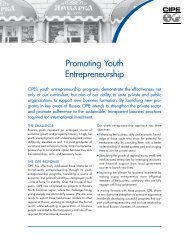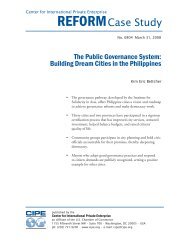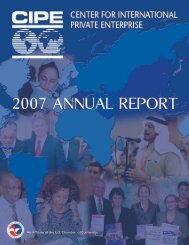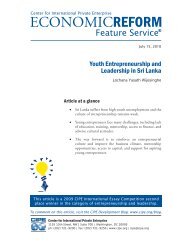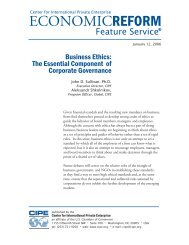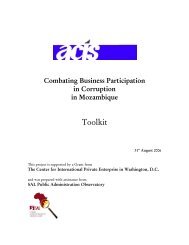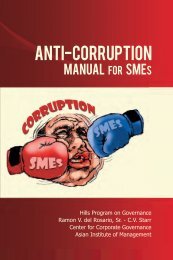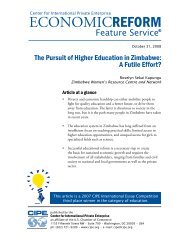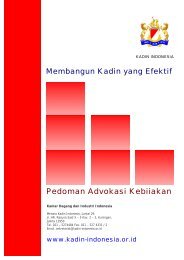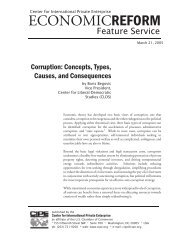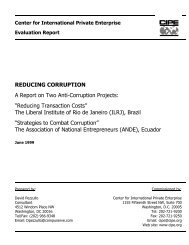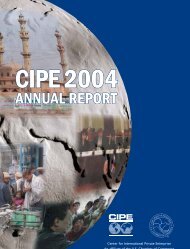Responsible Business Guide: A Toolkit for Winning Companies
Responsible Business Guide: A Toolkit for Winning Companies
Responsible Business Guide: A Toolkit for Winning Companies
Create successful ePaper yourself
Turn your PDF publications into a flip-book with our unique Google optimized e-Paper software.
RBG<br />
<strong>Responsible</strong> <strong>Business</strong> <strong>Guide</strong>: A <strong>Toolkit</strong> <strong>for</strong> <strong>Winning</strong> <strong>Companies</strong><br />
Why Being Financially Viable Comes First<br />
When a company’s turnover is sufficient to enable it to meet its operating costs, allow <strong>for</strong><br />
investments in development and technology, settle outstanding payables, maintain or<br />
increase levels of production or service delivery, and on top of all this leave a reasonable<br />
margin of profit, it is said to be financially viable. Accountancy norms suggest that this<br />
picture of financial viability comes in yearly cycles. In reality, however, companies must<br />
remain viable over much longer timelines to be successful.<br />
Major SRI Indexes<br />
Dow Jones Sustainability Index<br />
Ethibel Global Index<br />
Ethical Global Index<br />
FTSE4GOOD Global 100 Index<br />
Humanix 200 Global<br />
Natur-Aktien-Index<br />
ASPI Eurozone Index<br />
Ethinvest Environmental Index Australia<br />
Westpac-Monash Eco Index Australia<br />
Jantzi Social Index Canada<br />
UmweltBank-Aktien Index Germany<br />
Morningstar Japan SRI Index<br />
JSE / FTSE 4Good Index South Africa<br />
Humanix 50 Index Sweden<br />
Calvert CALVIN Social Index USA<br />
KLD Domini 400 Index USA<br />
Prevailing wisdom shows that the break-even point <strong>for</strong><br />
a business determines its trajectory of success over the<br />
long term. In the current environment, this break-even<br />
point is determined by more than just the ability to pay<br />
bills. Observers, particularly those who measure<br />
sustainability indicators, look at a company’s societal<br />
footprint to predict success. Assessing a company’s<br />
financial viability has become a complex, multifaceted<br />
task.<br />
This typically involves going beyond traditional evidence<br />
(such as audited accounts and financial per<strong>for</strong>mance<br />
statements, budgets, business strategies, growth<br />
projections, etc.) to look at newer indicators such as the<br />
environmental footprint, adherence to labor laws and<br />
health and safety regulations, employee benefits, credit<br />
ratings, and records of litigation. The picture that emerges<br />
indicates whether or not a company is financially viable.<br />
Inherent in this picture is the assumption that a company that is disciplined and prudent<br />
to stay financially viable is a company that can fulfill its obligations to its customers,<br />
employees, and governments. In recent years, ef<strong>for</strong>ts by regulatory agencies and tax<br />
authorities in Pakistan suggest a further tightening of controls <strong>for</strong> assessing a company’s<br />
long-term financial health. Matched with its ability to manage risks through the creation<br />
of liquidity mechanisms, assets, and social capital in the <strong>for</strong>m of credit, a company further<br />
indicates its sustainability.<br />
48<br />
<strong>Responsible</strong> <strong>Business</strong> Initiative



